So, you’ve probably noticed your feline friend meowing, purring, and maybe even giving you the occasional tail flick. But have you ever considered the depth of their communication beyond these obvious signs? Cats have a complex language all their own, filled with subtle nuances that may surprise you. Exploring the intricacies of how they convey their thoughts and feelings can offer a fascinating glimpse into the mysterious world of our beloved whiskered companions.
Key Takeaways
- Cats communicate through vocalizations, body language, tail signals, eye contact, and purring.
- Vocal cues like meows express specific emotions and needs.
- Body language, including ear and tail movements, conveys mood and intentions.
- Eye contact and pupil dilation reflect emotional states and communication cues.
- Purring, kneading, rubbing, and grooming are forms of feline communication and bonding.
Vocalizations
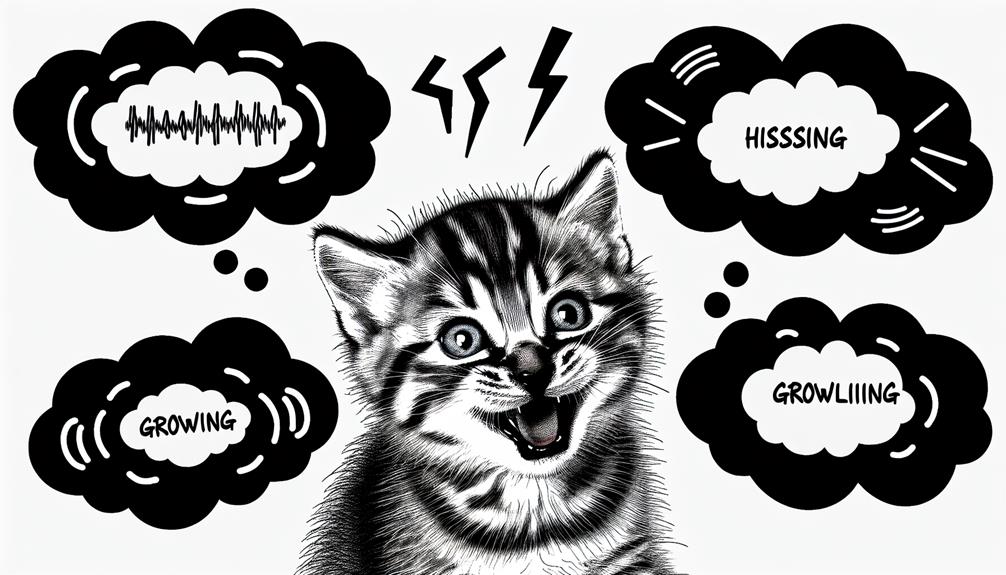
When cats communicate through vocalizations, they use a variety of sounds to convey their needs and emotions. Feline emotions play a significant role in the communication patterns of cats. You may have noticed that your cat produces different types of meows, each serving a specific purpose. For instance, a short and sharp meow may indicate excitement or a greeting, while a long and plaintive meow may signal discomfort or a request for attention. Paying attention to these nuances can help you better understand your cat’s emotional state.
Furthermore, purring is another vocalization that cats use to communicate. Contrary to popular belief, cats don’t only purr when they’re content. They may also purr when they’re in pain, anxious, or seeking comfort. Understanding the context in which your cat purrs can provide valuable insights into their well-being and emotions. By recognizing these subtle cues in your cat’s vocalizations, you can strengthen the bond between you and your feline companion.
Body Language
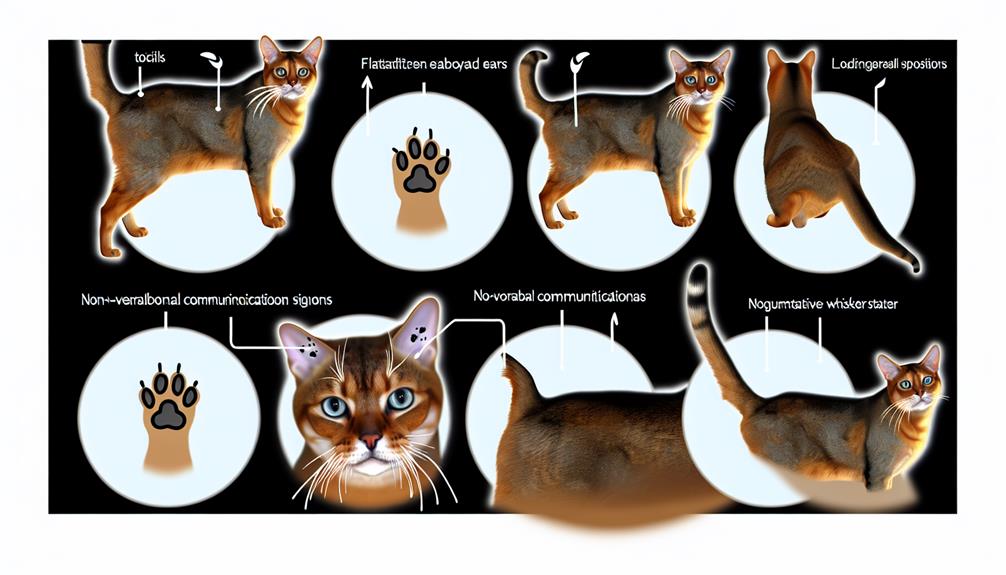
To understand your cat’s thoughts and feelings more deeply, observe their body language closely. Feline emotions can be expressed through a variety of non-verbal cues that your cat displays through their body movements.
When your cat arches their back and raises their fur, they may be feeling scared, threatened, or defensive. On the other hand, a relaxed cat often displays open body language, such as a loose posture and relaxed tail.
Pay attention to your cat’s ears as well; flattened ears could indicate fear or aggression, while forward-facing ears show curiosity or alertness. Additionally, a cat’s eyes can convey a lot about their mood – dilated pupils may suggest excitement or fear, while slow blinking can be a sign of trust and affection.
Tail Signals
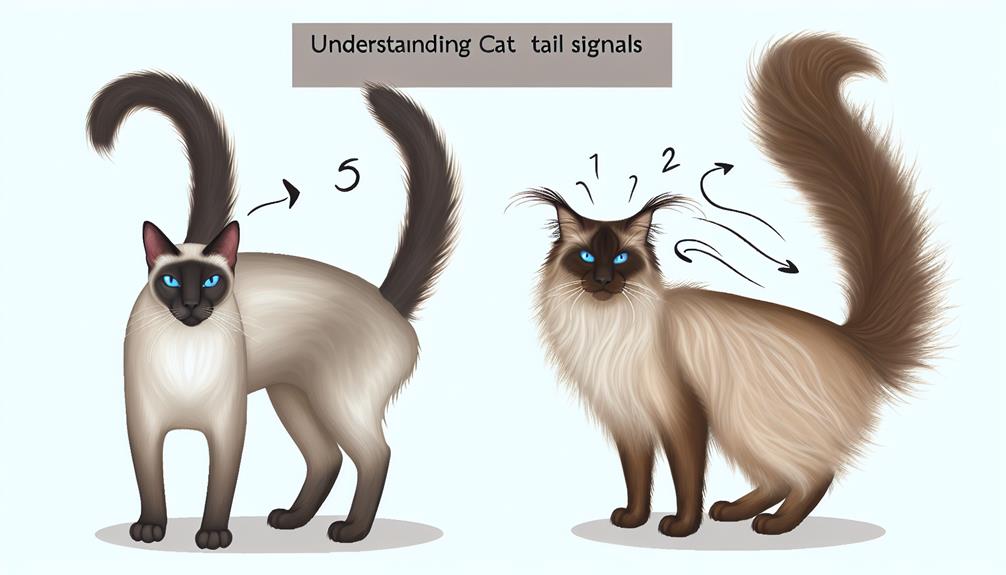
Observing your cat’s tail signals is a key aspect of understanding their communication methods. Cats use their tails to convey various messages and emotions. For instance, tail flicking is a common behavior that can indicate agitation or excitement. When your cat rapidly flicks its tail back and forth, it may be a sign of annoyance or frustration. On the other hand, a slowly swaying tail can signal a relaxed and content feline.
Additionally, the position of your cat’s tail is another important indicator of their emotions. A raised tail often signifies confidence and a friendly demeanor, while a tucked tail suggests fear or submission. If your cat’s tail is puffed up, it may be feeling threatened or alarmed.
Eye Contact
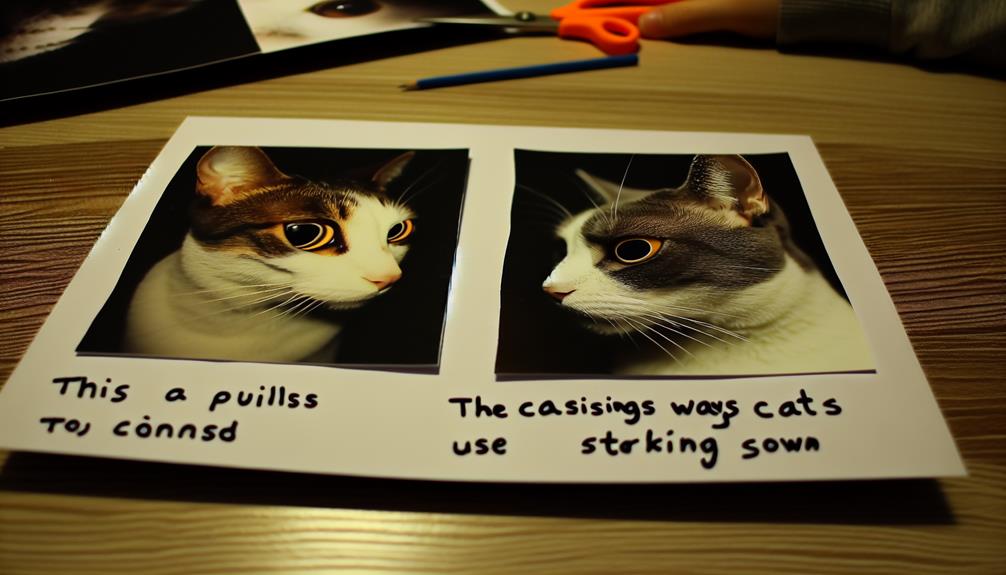
Understanding your cat’s eye contact can provide valuable insights into their communication cues and emotional state. Cats use their eyes to express a wide range of feline emotions. One crucial aspect to observe is pupil dilation. Dilated pupils can indicate excitement, fear, or aggression, while constricted pupils may suggest contentment or anger.
Blinking patterns also play a significant role in cat communication. Slow blinking is a positive sign in the feline world. When your cat locks eyes with you and blinks slowly, it’s like a kitty kiss, showing trust and affection. Responding with a slow blink can strengthen your bond with your furry friend. On the other hand, prolonged staring without blinking may be perceived as a challenge or threat.
Next time you interact with your cat, pay attention to their eyes. By understanding their pupil dilation and blinking patterns, you can better comprehend their feelings and improve your communication with your feline companion.
Purring
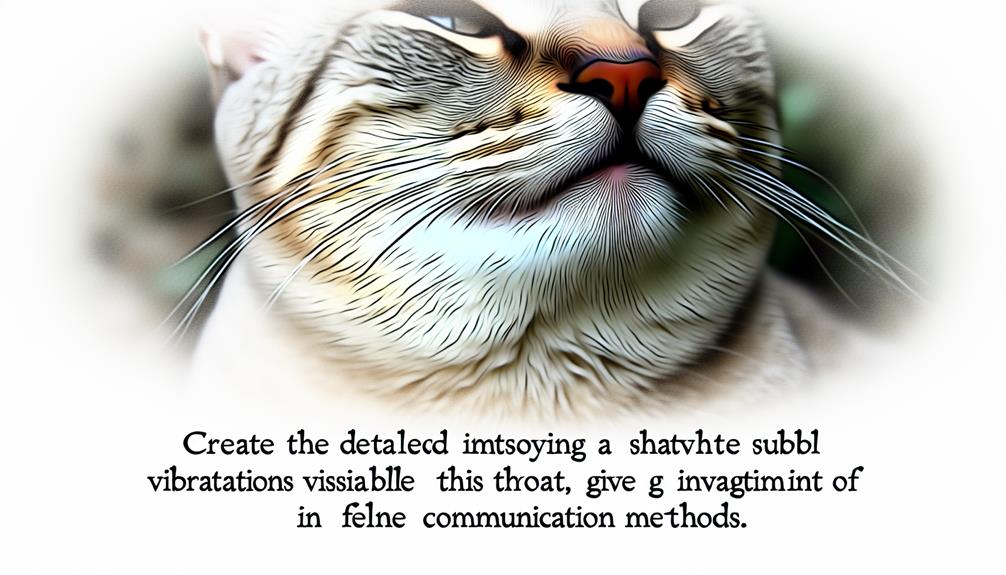
When your furry friend purrs, it’s not just a sign of contentment; it also holds healing properties and can even be a means of communication with you.
Cats use purring to express comfort, but it can also promote relaxation and reduce stress levels for both you and them.
Sound of Contentment
Cats convey their happiness through a gentle rumbling sound known as purring. This soothing sound isn’t just a sign of contentment; it also has therapeutic benefits. Purring has been linked to purring therapy, where the vibrations can trigger a relaxation response in both cats and humans.
The sound of happiness, feline satisfaction, emanates from a cat when it feels safe, comfortable, and loved. When your cat curls up beside you and purrs, it’s not only enjoying your company but also expressing its joy. Understanding the significance of purring can deepen your bond with your feline friend and provide insight into their emotional state.
Healing Properties
The gentle rumbling sound of purring, commonly associated with a cat’s contentment, actually holds healing properties that benefit both felines and humans. Cats’ purring isn’t just a sign of happiness; it also has therapeutic benefits. The low-frequency vibrations produced during purring have been linked to reducing stress, lowering blood pressure, and even promoting healing in bones and tissues.
Beyond its physical effects, purring serves as a form of non-verbal communication, creating an emotional connection between cats and their owners. When a cat purrs while snuggled up to you, it’s like receiving a healing touch that can bring comfort and a sense of calm. This subtle yet powerful behavior showcases the deep bond and understanding between cats and humans.
Communication With Humans
Purring serves as a unique form of communication between humans and cats, conveying comfort and emotional connection through its therapeutic vibrations. Understanding feline behavior plays a crucial role in interpreting this communication method.
When a cat purrs in your presence, it signifies a level of trust and contentment. Building trust with cats is essential for them to express themselves openly, and purring is a positive indicator of this bond.
Meowing
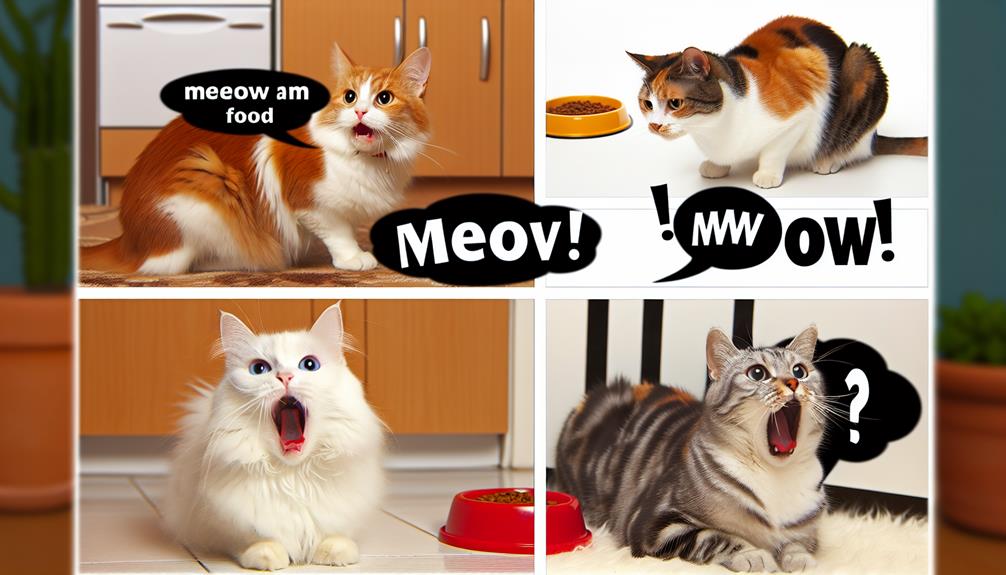
When your feline companion meows, they’re trying to communicate with you. Meowing frequency can vary greatly among cats, with some being more vocal than others. The frequency of meowing can depend on factors such as breed, age, and individual personality.
Meowing meanings can also differ based on the situation. Cats may meow to greet you, ask for food or attention, express discomfort or pain, or even just to engage in a conversation with you. Paying attention to the context in which your cat meows can help you understand their needs and emotions better. Some cats develop a repertoire of different meows, each serving a specific purpose.
It’s essential to listen to your cat’s meows and observe their body language to decipher what they’re trying to convey. By responding appropriately to your cat’s meows, you can strengthen the bond between you and ensure a harmonious relationship.
Kneading
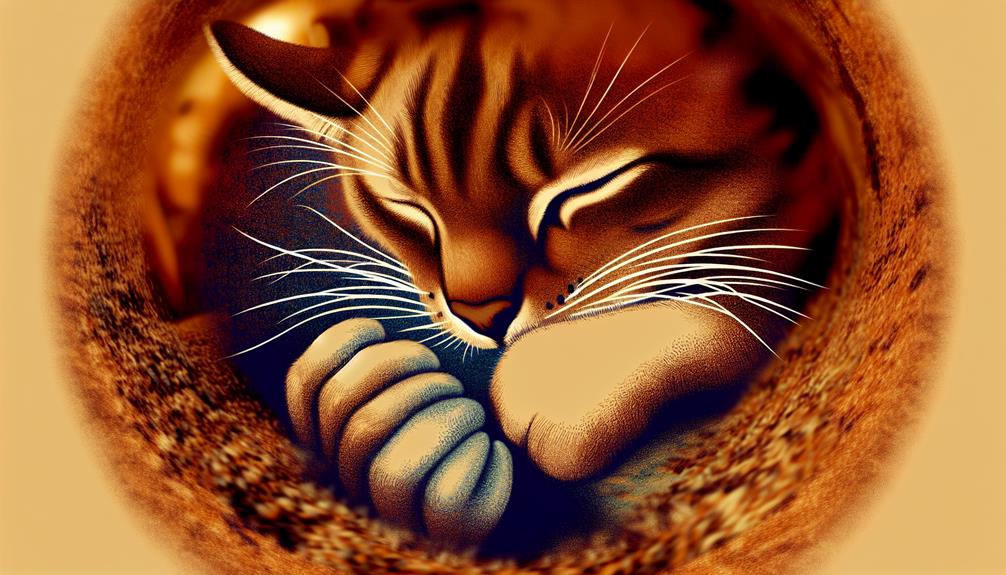
When your cat kneads you or a blanket, they’re showing their comfort and contentment.
This behavior is deeply ingrained in them as a way to bond with their mother during nursing.
Understanding this instinctual gesture can help you strengthen your relationship with your feline companion.
Cat’s Comfort Behavior
Cat’s comfort behavior, known as kneading, is a common and instinctual action performed by domestic felines. This behavior, often accompanied by comforting purring, involves your cat rhythmically pushing their paws against a soft surface.
Kneading is a soothing action that cats typically engage in when they’re feeling content, relaxed, or seeking comfort. This behavior is rooted in kittenhood when they knead their mother’s belly to stimulate milk flow. The act of kneading helps cats release tension, mark their territory with scent glands in their paws, and create a cozy space for themselves.
Instinctual Bonding Gesture
Engage with your cat’s instinctual bonding gesture by appreciating the rhythmic kneading they perform. This behavior is more than just your feline friend getting comfortable; it stems from deep-rooted instincts related to nurturing and comfort.
When your cat kneads on your lap or a soft blanket, they’re displaying a bonding behavior that goes back to kittenhood when they kneaded their mother’s belly to stimulate milk flow. This rhythmic motion not only indicates contentment but also serves as a form of purring therapy for your cat.
Rubbing
To establish familiarity and ownership, cats often rub against objects and people. This behavior serves as a form of scent communication, as cats have scent glands on their face, paws, and flanks that release pheromones when they rub against things. By leaving their scent on you or objects in your home, cats are essentially marking their territory and creating a sense of belonging.
In addition to marking their territory, rubbing also plays a crucial role in social bonding among cats and their human companions. When your cat rubs against you, they aren’t only depositing their scent but also seeking comfort and closeness. It’s their way of showing affection and strengthening the bond between you.
Grooming

When grooming, you’ll observe your cat meticulously cleaning itself from head to tail, using its tongue and teeth to remove dirt, debris, and loose fur. Grooming isn’t just about cleanliness; it also serves as a vital aspect of your cat’s hygiene habits. Cats are meticulous groomers, spending a significant portion of their day on this activity to maintain their sleek coats and remove parasites.
Apart from hygiene, grooming plays a crucial role in social bonding among cats. When cats groom each other, it’s a sign of trust and affection. This behavior is often seen in bonded pairs or groups of cats living together. Mutual grooming helps strengthen their social bonds and maintain a harmonious relationship within the group.
Play Behavior
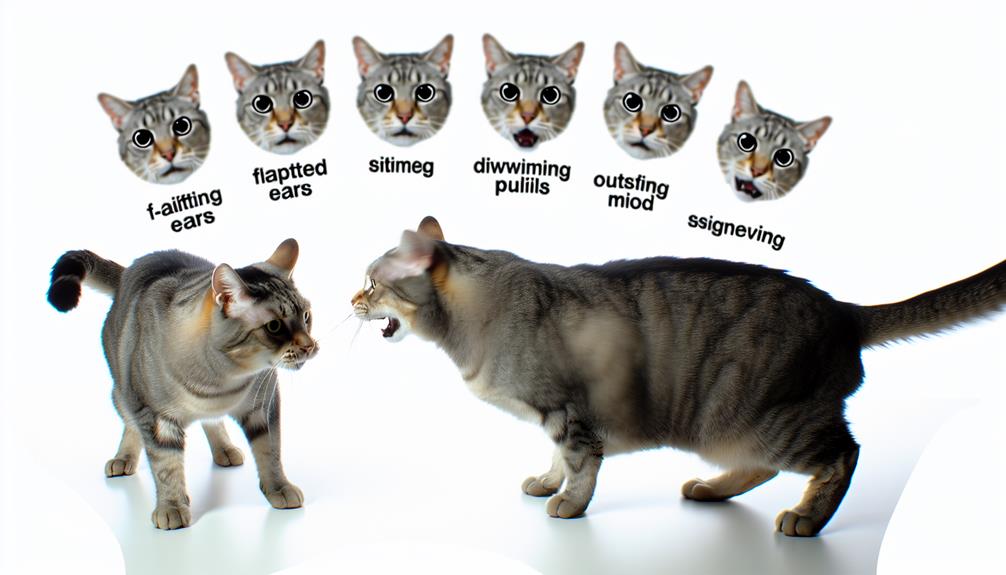
Let’s talk about how your cat communicates through play behavior.
Body language cues, vocalizations during play, and tail movements are all significant aspects to observe.
Understanding these signals can help you better interpret your cat’s intentions and feelings during playtime.
Body Language Cues
Body language cues during play behavior can provide valuable insights into a cat’s communication. When engaging in play, a cat’s ear positions and body language can reveal its intentions. Ears perked forward suggest excitement and engagement, while flattened ears may indicate aggression or fear.
Additionally, whisker movements play a significant role in feline communication during play. Forward-facing whiskers often signal a cat’s alertness and interest, while whiskers pulled back against the face may indicate discomfort or irritation. Understanding these subtle cues can help you interpret your cat’s behavior accurately and enhance your bond by responding appropriately to their play signals.
Paying attention to these non-verbal cues can lead to more enjoyable and meaningful play sessions with your feline companion.
Vocalizations During Play
During play behavior, cats use a variety of vocalizations to communicate their excitement and engagement with you as their playmate. Playful interactions are often accompanied by specific vocal cues, such as chirps, trills, and meows. These sounds indicate that your cat is enjoying the interactive play and sees you as a participant in their games.
Cats may also use different communication cues during play to convey their mood or intentions. Pay attention to the tone and volume of their meows or purrs, as these can provide valuable insights into how they’re feeling during the play session. Understanding these vocalizations can help strengthen the bond between you and your feline companion while enhancing the overall play experience.
Tail Movements Significance
When observing your cat’s tail movements during play, you can gain valuable insights into their mood and intentions. Tail flicking can indicate a dominance display, showing that your cat is feeling confident and in control during the play session.
On the other hand, if your cat wraps their tail around you or another cat, it’s often an affectionate greeting, showcasing their bond and trust in the relationship. Understanding these subtle cues can help you better interpret your cat’s behavior and strengthen your connection with them.
Aggression Signs
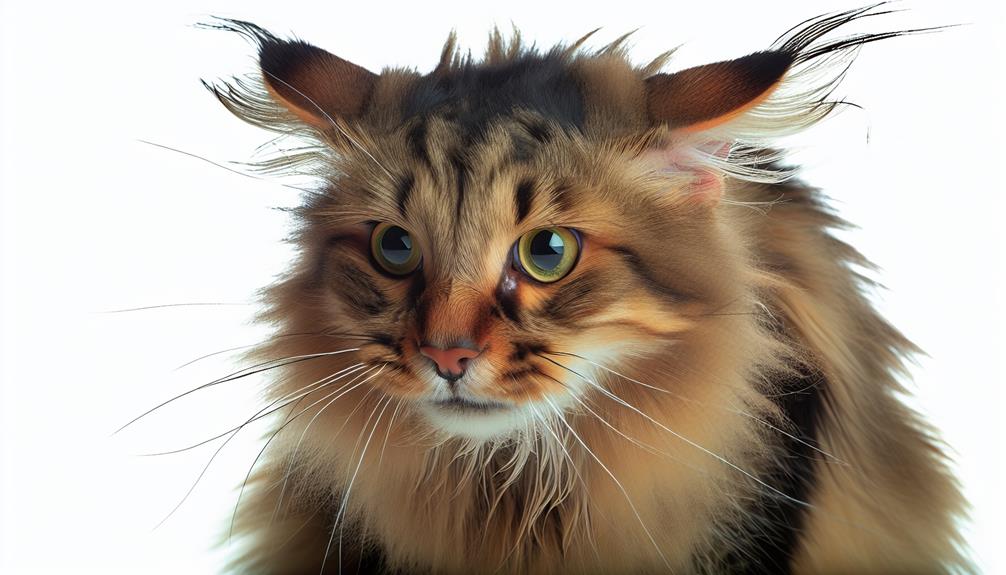
What’re the telltale signs of aggression in cats? Cats can display aggression for various reasons, and it’s essential to recognize the warning signs to prevent any potential harm.
Here are five key indicators to watch out for:
- Hissing and Growling: These vocalizations are common signs of a cat feeling threatened or aggressive.
- Ears Pinned Back: When a cat’s ears are flattened against its head, it often signifies that the cat is agitated or ready to strike.
- Dilated Pupils: Enlarged pupils can indicate heightened arousal, which may lead to aggressive behavior.
- Raised Fur: A cat’s fur standing on end, especially along the back, is a clear signal of aggression.
- Swatting or Scratching: Physical actions like swatting with paws or scratching are direct signs of aggression.
If you notice these signs, it’s crucial to address the situation promptly. Consider exploring behavioral modification techniques and calming strategies to help manage your cat’s aggression effectively.
Socialization
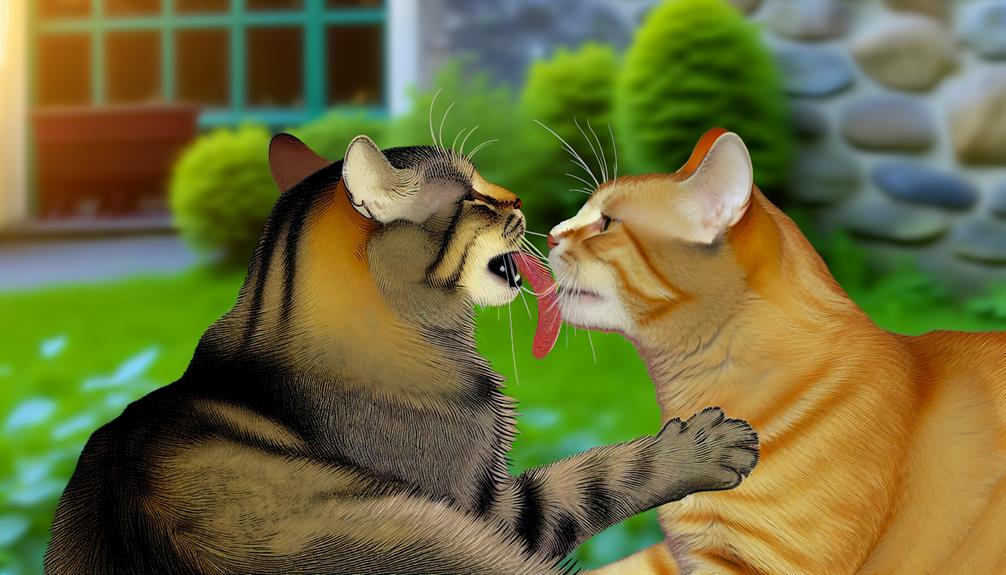
To ensure your cat develops positive social behaviors, early exposure to various environments and interactions with different people and animals is key. Playful interactions with humans and other pets are crucial for fostering social bonding in cats. When kittens engage in play with their littermates or other animals, they learn important social skills like communication, boundaries, and cooperation.
Understanding feline hierarchy is also essential for proper socialization. Cats are known for their intricate social structures where dominance plays a significant role. By exposing your cat to different social situations early on, you can help them navigate these hierarchies and develop appropriate social behaviors.
Encouraging positive social dominance in your cat involves providing opportunities for them to interact with other animals in a safe and supervised manner. This can help prevent aggressive behaviors stemming from insecurity or fear. By promoting healthy socialization through varied interactions, you can help your cat become a well-adjusted and socially adept companion.
Marking Territory
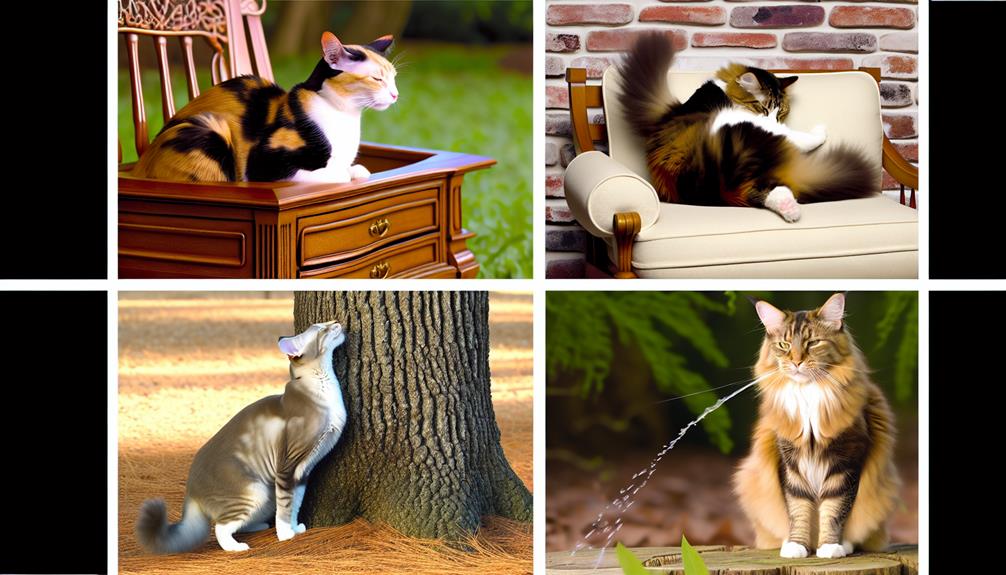
Let’s talk about how cats mark their territory.
They use scent marking behavior and visual territorial displays to communicate boundaries.
Understanding these behaviors will help you interpret your cat’s needs and interactions with other animals.
Scent Marking Behavior
Cats communicate by scent marking their territory using specialized scent glands located on their face, paws, and tail. This behavior is essential for establishing boundaries and conveying information to other cats in the area. When cats engage in scent marking, they’re engaging in a form of social behavior that helps maintain order and reduce conflicts.
Here are some key points to understand about scent marking in cats:
- Scent communication plays a crucial role in marking patterns.
- Cats use scent marking to claim their territory.
- Different scent glands produce unique fragrances for communication.
- Marking objects with scent helps cats navigate their surroundings.
- Scent marking can also be a way for cats to communicate their reproductive status.
Visual Territorial Displays
Visual territory marking in cats involves the use of strategic body language to communicate ownership and boundaries to other felines in the vicinity. Cats utilize visual marking to establish territorial boundaries and assert their territorial ownership. They achieve this through behaviors like rubbing their face against objects, scratching surfaces, and even spraying urine in certain cases.
Facial Expressions
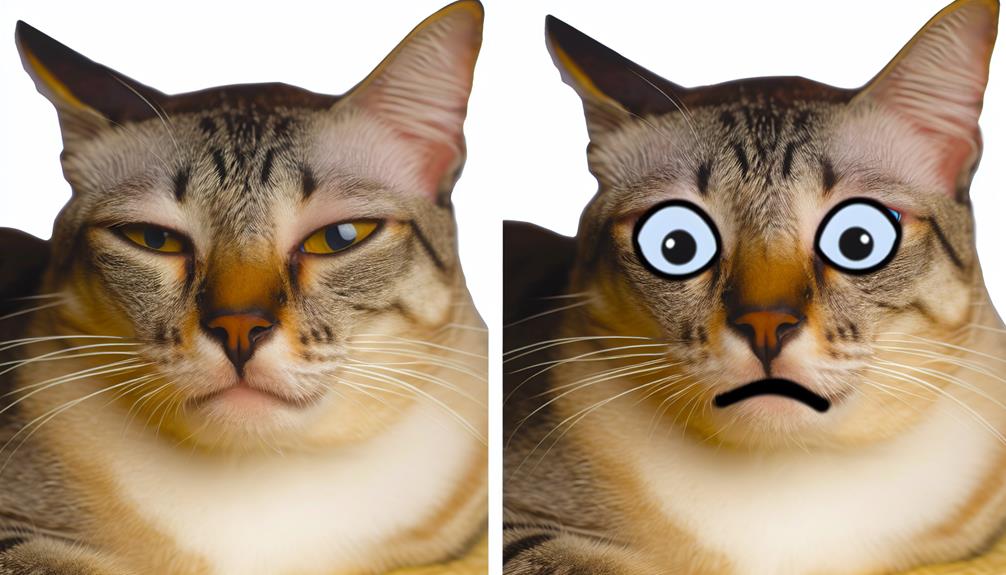
When observing cats, pay close attention to their facial expressions as they provide valuable insights into their emotions and intentions. Cats communicate a lot through their facial expressions, and understanding these cues can help you better comprehend what they’re feeling or trying to convey. Here are some key things to look out for:
- Ear movements: Cats often move their ears to show their current mood or level of alertness.
- Whisker twitches: Pay attention to the subtle movements of their whiskers, as they can indicate if a cat is feeling threatened or curious.
- Pupil dilation: The dilation of a cat’s pupils can reveal a lot about their emotional state, with dilated pupils often indicating excitement or fear.
- Facial expressions: Just like humans, cats can convey a range of emotions through their facial expressions, such as happiness, contentment, or annoyance.
Communication With Humans
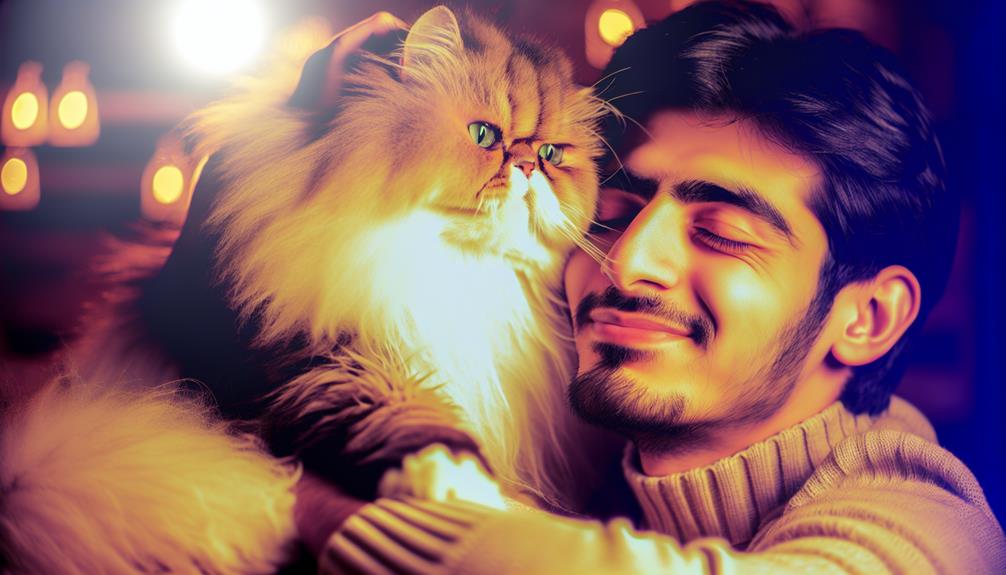
Understanding how felines communicate with humans can deepen your bond with these enigmatic creatures. Cats are known for their feline empathy and can form strong connections with their human companions. To enhance this bond, pay attention to their nonverbal cues. Cats communicate through subtle body language, vocalizations, and even eye contact. By understanding these signals, you can build rapport with your cat and strengthen your relationship.
When interacting with your cat, observe their body posture. A relaxed cat with their tail up and ears forward signifies contentment, while a tense body and flattened ears may indicate discomfort. Additionally, meowing, purring, and chirping are ways cats vocalize their feelings and needs. Responding appropriately to these sounds can help foster better communication.
Creating a safe and trusting environment is crucial for effective communication with your cat. By respecting their boundaries and responding to their cues, you can establish a strong connection based on mutual understanding and trust.
Frequently Asked Questions
Can Cats Communicate With Other Animals Besides Humans?
Yes, cats can communicate with other animals besides humans through various methods. Interspecies communication is possible through body language, vocalizations, and pheromones. Cats use these tools to convey messages and establish relationships with different species.
Do Cats Use Different Communication Methods With Kittens?
When communicating with kittens, cats rely on their maternal instincts to convey messages. Through a combination of body language, vocal cues, and grooming behaviors, they establish bonds and teach important skills to their young.
How Do Cats Communicate Their Emotions Through Scent?
To communicate their emotions through scent, cats use pheromones to convey signals like comfort or stress. They also rely on body language, such as rubbing against objects or tail movements, to express feelings.
Are There Regional Variations in Cat Communication Signals?
Regional differences in cat communication signals exist. Cats use non-verbal cues like body language, vocalizations, and scent marking to communicate. Understanding these variations can help you better interpret your feline companion’s behavior and needs.
Can Cats Communicate With Each Other Over Long Distances?
Yes, cats can communicate with each other over long distances using pheromone trails to mark territory and vocalizations to establish territorial boundaries. These signals help cats navigate their environment and interact with other felines effectively.
Conclusion
In conclusion, cats communicate through a variety of vocalizations, body language, and subtle cues to express their mood, needs, and intentions. Understanding these signals helps strengthen the bond between humans and feline companions, creating a deeper connection and enhancing the relationship.
By paying attention to their meows, purrs, tail signals, and other forms of communication, you can better understand and respond to your cat’s emotions and behaviors. Keep communicating with your cat to build a strong and loving relationship.






